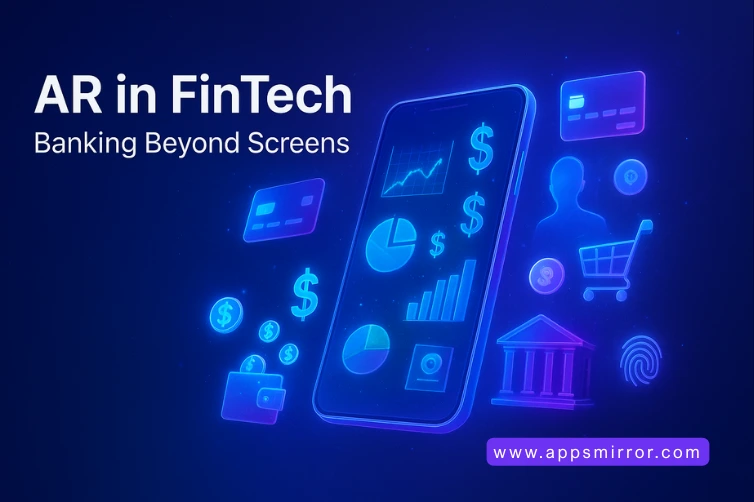Money Gets a Glow-Up
Imagine opening your phone or slipping on a pair of AR glasses and seeing your bank account projected as a 3D model right in front of you. Instead of scrolling through endless lists of numbers, you could watch your income and expenses animate across your dining table. Investments could be displayed as towers rising and falling in real time, while your savings account could appear as a steadily filling digital jar. Augmented Reality (AR) is not just about games or filters anymore; it is quietly but powerfully making its way into the world of AR in FinTech.
For decades, managing money has been a task wrapped in complexity. People often find financial terms overwhelming and struggle to visualize their future goals. AR aims to change that narrative by turning finance into something visual, engaging, and more human-friendly.
Branchless, Boundless Banking
FinTech has already disrupted traditional banking by moving much of the experience online. Mobile wallets, tap-to-pay systems, and quick loan approvals have set the stage. With AR, we take the leap from flat mobile screens to immersive environments. Picture walking into a store, pointing your phone at a product, and seeing personalized financing options appear instantly. Instead of waiting in line for a banker to explain your mortgage, a holographic advisor could appear in your living room and walk you through the details step by step.
For cross-border banking, AR could also play a role in reducing communication gaps. Imagine a customer in India applying for a service from a bank in London and interacting with a holographic banker who speaks their language. This creates opportunities for financial inclusivity in ways we have not experienced before.
Security Meets Sci-Fi
Whenever new technology enters finance, the first question is always about safety. Nobody wants their money floating around in cyberspace waiting to be intercepted. That is why AR-driven financial tools are being paired with advanced security features. Biometric authentication, such as facial recognition or even spatial recognition of your environment, adds extra layers of security.
Developers are also working on encrypted AR layers so that sensitive data cannot be intercepted when it appears in front of you. Still, challenges remain. How do you ensure privacy if your banking dashboard is projected in a public space? What if malicious AR apps attempt to mimic banking interfaces? These are the issues financial institutions will need to solve before AR becomes mainstream.
Who’s Making It Happen
Several global players are already laying the groundwork for AR in FinTech. Apple and Google, through their ARKit and ARCore frameworks, are creating the technology base that banks and startups can build upon. Payment platforms like PayPal and Square are exploring AR-based dashboards for business users who want to visualize transactions in a more interactive way. Major banks such as Citi and HSBC have invested in AR data visualization experiments to help customers understand complex financial products.
This is not science fiction—it is happening now, but adoption is slow. One major barrier is hardware. While smartphones support basic AR, more advanced experiences require AR glasses, which are still expensive and not widely adopted.
The Ups and Downs
Like any new technology, AR in finance comes with both opportunities and challenges.
Merits:
- Makes financial management more intuitive and less intimidating.
- Offers global accessibility, reducing the need for physical bank branches.
- Improves financial literacy through gamified, interactive learning experiences.
- Provides real-time visualization of investments and expenses.
Demerits:
- High cost of implementation for banks and startups.
- Limited adoption due to expensive AR devices.
- Potential privacy and fraud risks if interfaces are not secured properly.
- Risk of over-reliance on visuals that may oversimplify complex decisions.
What’s Next
The real magic will happen when AR merges with artificial intelligence. Imagine an AR assistant that not only displays your bank balance but also predicts your spending habits, identifies unnecessary subscriptions, and suggests personalized investment opportunities. This type of financial guidance could help younger generations build healthier financial habits early on.
In the future, AR may become a default interface for personal finance, especially as hardware becomes lighter, cheaper, and more mainstream. Just as ATMs and mobile banking once redefined finance, AR has the potential to bring a new chapter—one where money is not hidden in apps or spreadsheets, but visible, dynamic, and easy to understand.
Technology for Good
The promise of AR in FinTech is not just about novelty. It is about making finance more transparent, more accessible, and less overwhelming for everyone. If executed responsibly, AR can transform the way we save, spend, and invest, reinforcing the mantra that technology should ultimately serve people.





